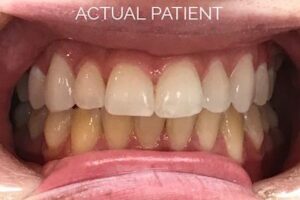Benefits of Porcelain Veneers
Benefits of Porcelain Veneers
 Revive the look and functionality of your smile with porcelain veneers from our cosmetic dentist, Eric Spellman, DMD. We provide general and cosmetic dentistry treatments in Larchmont, NY. Our services ensure that you can receive the utmost benefits of porcelain veneers. With dental veneers, you are able to both protect and cover your current teeth and gums for a more efficient smile makeover. Find out more about these benefits to discover how much our cosmetic dentistry can change your smile for the better.
Revive the look and functionality of your smile with porcelain veneers from our cosmetic dentist, Eric Spellman, DMD. We provide general and cosmetic dentistry treatments in Larchmont, NY. Our services ensure that you can receive the utmost benefits of porcelain veneers. With dental veneers, you are able to both protect and cover your current teeth and gums for a more efficient smile makeover. Find out more about these benefits to discover how much our cosmetic dentistry can change your smile for the better.
Improve Your Smile
The ultimate benefit of having porcelain veneers designed by a professional cosmetic dentist is to have a more attractive smile. Veneers made from porcelain are custom-made to match the rest of your teeth in color. Furthermore, the porcelain material is also long-lasting and durable. You can live your life without having to worry whether the veneer will come off. A porcelain veneer is also stain resistant so you can rest assured that your dental treatment will last for years. Let our dental office, Eric Spellman, DMD, in Larchmont, NY assist you with improving your smile with dental care.
Enjoy Better Oral Health
Along with improving the way you look, a specialist can provide you with individual tooth treatments for optimal oral health care overall. Using porcelain veneers you can correct and cover chipped or cracked teeth. In addition, the dental veneers help protect against future dental damage. You are also going to reduce and hopefully eliminate any pain associated with crooked or chipped teeth.
After all, when you have chipped or broken teeth, this reveals the root endings. This often leads to intensive chronic pain as you suffer from unprotected teeth. Save your teeth including damaged teeth with the use of veneers made of porcelain. Reduce discomfort and protect against tooth decay and oral pain with porcelain veneers in Larchmont, NY. This can also help you save money in the long run on oral health care. Choose dental veneers as part of your preventative dental services today.
Contact Eric Spellman, DMD For Porcelain Veneers
Here at our dentist office in Larchmont, Eric Spellman, DMD, we offer many cosmetic dentistry treatments, including, porcelain veneers in Larchmont, NY. Other cosmetic treatments include partial and full dentures, dental implants, and Invisalign clear braces. By providing advanced dental treatments for patients in Larchmont, we also help you save time and money. To start seeing the benefits of porcelain veneers today, contact Dr. Eric Spellman at 914-315-4446 to schedule an appointment.


 To transform your smile with a professional cosmetic dentist, the office of
To transform your smile with a professional cosmetic dentist, the office of  When you smile, can you see a lot of your gums? Do you feel like your teeth look shorter than normal or that the pink of your gums is the dominant feature? If so, you may have what is known as a ‘gummy smile’ – a fairly common problem cosmetic issue. Fortunately, there are several
When you smile, can you see a lot of your gums? Do you feel like your teeth look shorter than normal or that the pink of your gums is the dominant feature? If so, you may have what is known as a ‘gummy smile’ – a fairly common problem cosmetic issue. Fortunately, there are several  Visiting the dentist can be an incredibly anxious experience for some people. In fact, it is a common reason that people put off dental work which can result in an even more serious condition. For individuals who avoid the dentist at all costs, sedation dentistry may be a solution. Understanding the perks of this service could influence a person’s decision to seek the dental work that they desperately need.
Visiting the dentist can be an incredibly anxious experience for some people. In fact, it is a common reason that people put off dental work which can result in an even more serious condition. For individuals who avoid the dentist at all costs, sedation dentistry may be a solution. Understanding the perks of this service could influence a person’s decision to seek the dental work that they desperately need. You’ve seen the kinds of toothpaste every time you go to the store that state that they have the best whitening ingredients or the best results, maybe you’ve even tried one or two. However, the results have been all over the map for so many people. If you haven’t tried it, you must wonder if it even works, or if you are better off to try strips, or trays. In order to answer your questions, we’ve compiled some information to help you better understand when you should use a whitening toothpaste, and when you need to enlist the help of a professional.
You’ve seen the kinds of toothpaste every time you go to the store that state that they have the best whitening ingredients or the best results, maybe you’ve even tried one or two. However, the results have been all over the map for so many people. If you haven’t tried it, you must wonder if it even works, or if you are better off to try strips, or trays. In order to answer your questions, we’ve compiled some information to help you better understand when you should use a whitening toothpaste, and when you need to enlist the help of a professional.